

Picking the right DevOps toolset with the best functionalities has a huge impact on the productivity of the humans on your teams and the functionality of the apps they develop. And besides, doing all the work without good tools is less fun. ✨
In this article, we will take a look at the latest DevOps tools with an eye toward those that emphasize automation, monitoring, and other critical features so you and your team can get to the good stuff of creating and deploying great code. 🙌
What is DevOps?
DevOps is a methodology for managing software development that combines practices and tools for both software development (Dev) and IT operations (Ops).
Each practitioner defines their DevOps lifecycle differently, but the most common phases in the workflow are:
- Continuous Development: Planning and coding the software
- Continuous Integration: Commit changes to the source code frequently
- Continuous Testing: Automated tests to evaluate changes to the code
- Continuous Deployment: Tested and approved software is placed on production servers, also called continuous delivery
- Continuous Monitoring and Observability: Track and document the entire DevOps process
- Continuous Feedback: Information from software usage is fed back to DevOps teams
- Continuous Operations: Automation of the release and the application deployment process
Many of the key aspects of DevOps come from agile, but there is a difference between agile and DevOps practices.
What Should You Look for in a DevOps Tool?
By its nature, DevOps requires multiple tools to work in a cross-functional way to assist in the entire software production lifecycle. This is called the DevOps toolchain, and each tool addresses one or more phases in the DevOps lifecycle.
To have the most effective toolchain end-to-end for your production environment, you should consider the following aspects of each tool you look at:
- Compatibility between each tool in the toolchain and outside tools. Information should flow easily from one tool to another.
- Enable easy communication and collaboration within and across teams. This includes project management, tracking specifications, and communicating the results of continuous feedback.
- Automation of integration and deployment, referred to as the DevOps pipeline or Continuous Integration and Continuous Deployment (CI/CD).
- Simple and automatic capture and logging of actions taken across the toolchain.
- Features that automate or simplify common tasks that take time when done manually. A great example is the ability to use a template to automatically generate release notes.
- Flexible functionality that adapts to the most efficient process rather than forcing the process to adapt to the tool.
The 10 Best DevOps Tools for End-to-End Project Success
Now that we have a good background in place, here is a list of the 10 best DevOps tools available today.
1. ClickUp

See the 15+ views in ClickUp to customize your workflow to your needs
ClickUp is a cloud-based project management and collaboration tool with strong integration with other common DevOps tools. It provides many of the features software development teams need to implement DevOps, along with a powerful and easy-to-use project management platform.
Best for:
- Collaboration between and across teams
- DevOps project management
- Planning, task assignment, scheduling, and progress tracking during development
- Capturing and sharing the results of monitoring
- Tracking and conveying feedback
ClickUp best features:
- Cloud-based tool for project document creation and collaboration
- Automation tools within ClickUp and other common DevOps tools
- Useful collaboration and tracking tools like milestone tracking, Kanban boards, whiteboards, and a variety of charts and graphs
- View your project as a Map, Table, Timeline, or any other style that works best for you
- User tagging and comments on all tasks
- Establish dependencies and track progress
- Robust and flexible templates to ramp up fast while ensuring consistency, including specific templates for agile workflows.
- Powerful and simple integrations with outside tools like Google Drive, Salesforce, Basecamp, and solutions from many providers, including popular open-source tools
- Runs on-premise or in the cloud
- Visualize your projects with ClickUp Mind Maps
ClickUp limitations:
- So many features and capabilities can challenge new users
- Some features, like Table view, are not yet available on the mobile app
- Email notices and reminders can become overwhelming
ClickUp pricing:
- Free Forever: $0
- Unlimited: $5/month per user
- Business: $12/month per user
- Business Plus: $19/month per user
- Enterprise: Contact for pricing
ClickUp ratings and reviews:
- G2: 4.7/5 (6,600+ reviews)
- Capterra: 4.7/5 (3,600+ reviews)
2. Miro
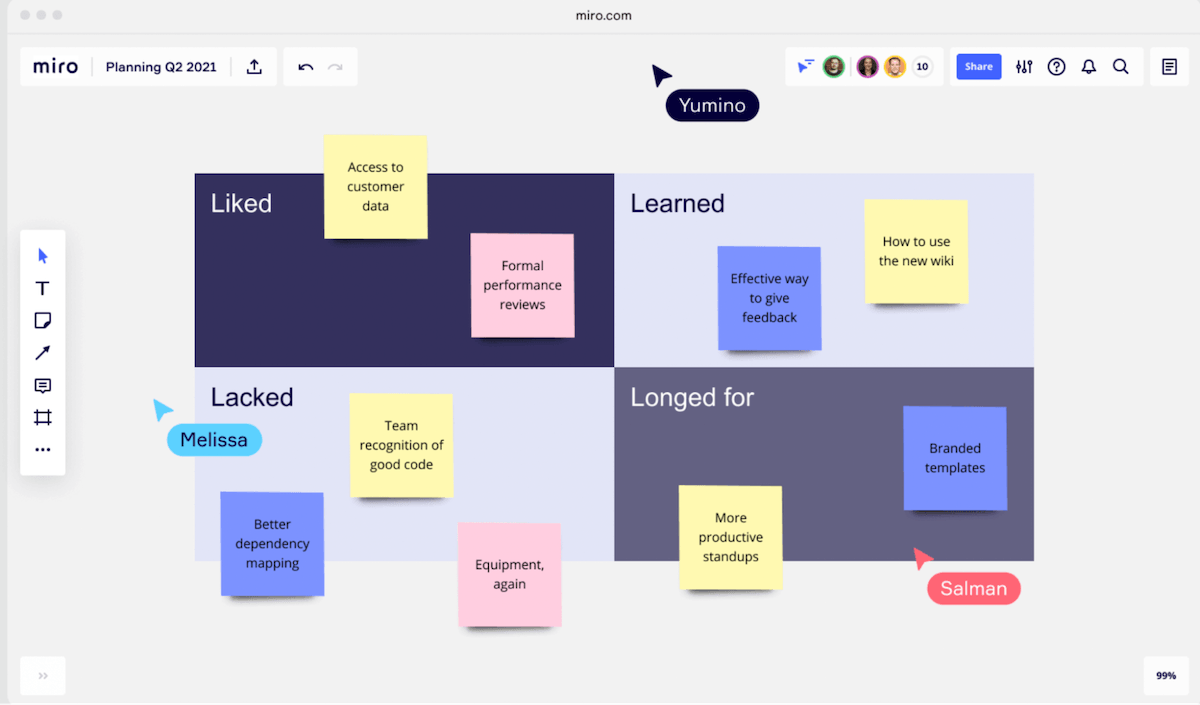
Miro is a digital whiteboard platform with multiple tools used by teams to meet online, collaborate, present, and share their ideas and work visually. It is one of the most popular whiteboard project management tools. It can be used to display visual information during meetings, plan complete project workflows, or give presentations.
Best for:
- Brainstorming, organizing specifications, and planning tasks during development
- Reviewing, discussing, and developing actions for feedback
- Presenting testing results
Miro best features:
- Supports most file types, including GIFs, PDFs, spreadsheets, images, and more
- Fully functional video conferencing while also sharing the whiteboard
- Agile workflows
- Infinite canvas
- Supports a large number of interactive users at the same time
- Simple and easy-to-use interface
- Large template library for workflows, mind maps, and Kanban boards
- Integration with common DevOps tools
Miro limitations:
- No linking or tagging makes connecting information difficult
- Very little offline capability
- Navigation around the whiteboard is confusing and takes some time to learn
- Limited sketching and editing tools
Miro pricing:
- Free: $0
- Starter: $8/month per user
- Business: $16/month per user
- Enterprise: Contact for Pricing
Miro ratings and reviews:
- G2: 4.8/5 (4,400+ reviews)
- Capterra: 4.7/5 (1,100+ reviews)
3. Confluence
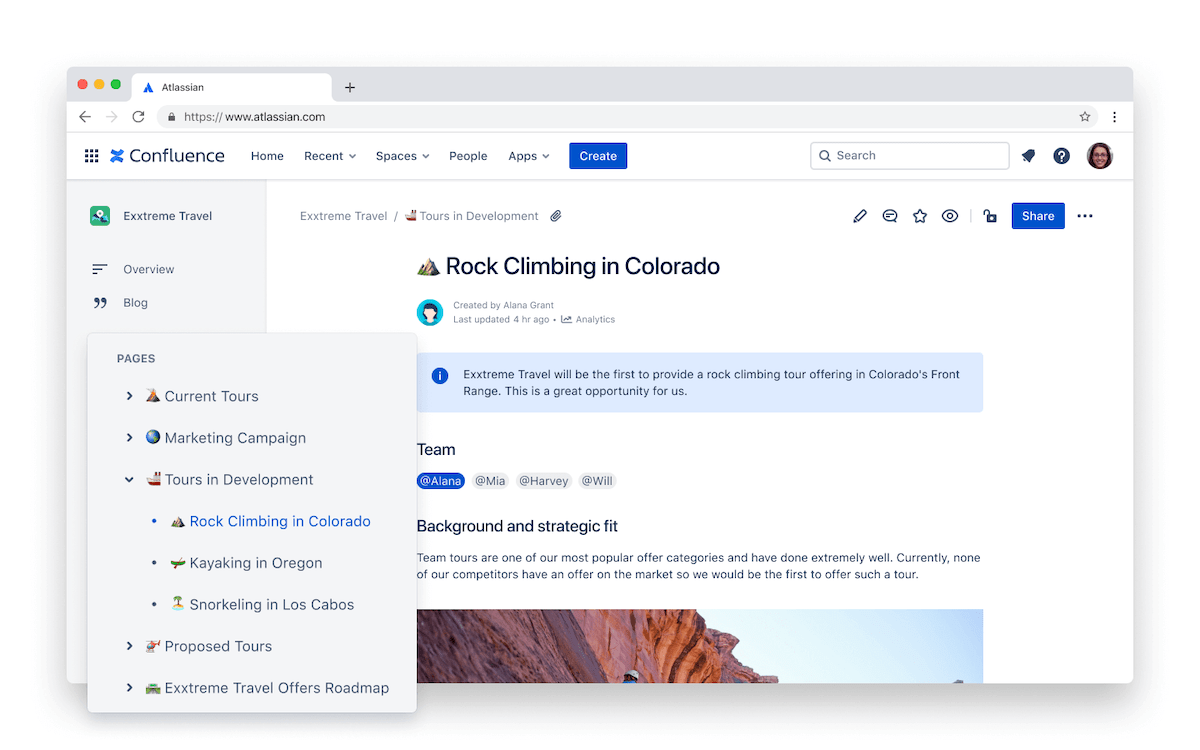
Confluence is a team workspace for knowledge capture and collaboration built for remote teams. Beyond its collaboration features that help team members creatively collaborate, Confluence provides documentation, project management, analytics, reporting, and workflow automation.
Users create spaces where they can assign tasks, collect and organize information, streamline processes, and interact through conversations. Confluence is part of the Atlassian DevOps suite.
Best for:
- Defining steps and functionality during development
- Capturing feedback
- Documenting test results
Confluence best features:
- Strong Jira integration
- Page labels to make finding content simpler
- Built to support agile workflows
- Simple social engagement tools and customizable notifications
- Fully featured rich text editor
- User tagging that generates emails to the named users
Confluence limitations:
- Search is not as accurate as it could be
- Uploading and formatting content can be difficult for new users
- Difficult to organize workspaces in an intuitive way
Confluence pricing:
- Free: $0
- Standard: $5.75/month per user
- Premium: $11/month per user
- Enterprise: Contact for pricing
Confluence ratings and reviews:
- G2: 4.1/5 (3,500+ reviews)
- Capterra: 4.4/5 (2,800+ reviews)
4. Docker

Docker is a platform for software development, test automation, and software delivery using containerized images. A container is an isolated version of the software that runs the same regardless of which operating system it is running on or programming language that was used, avoiding the need to spin up virtual machines.
The Docker platform includes user, command line, and application programming interfaces (UIs, CLIs, and APIs) and security to support every step of the software development lifecycle.
Best for:
- Building software during development
- Managing integration
- Testing within containers for application performance monitoring and robustness
- Deploying applications in containers
- Automated operations for integration, testing, and deployment
Docker best features:
- Robust implementation of container orchestration
- Flexible set of tools
- Supports most operating systems, including Windows, Linux, and MacOS
- Strong integration with industry-leading tools
- Powerful CLI making deployment simple
- Large and active user community
- Large library of preconfigured environments
Docker limitations:
- Reliance on the command line interface can be difficult at times
- The concepts behind containers can be confusing and hard to understand
- Images can be very large and use significant resources
Docker pricing:
- Personal: $0
- Pro: $5/month, single user
- Team: $9/month per user
- Business: $24/month per user
Docker ratings and reviews:
- G2: 4.6/5 (100+ reviews)
- Capterra: 4.6/5 (400+ reviews)
5. GitHub

GitHub is the most commonly used set of high-quality configuration management tools for software development. It is a version control system built on Git for distributed development teams by providing a single repository with check-in and check-out.
In addition, GitHub includes access control, bug tracking, request management, task management, and automation, along with many other features. GitHub is owned by Microsoft and runs on Azure.
Best for:
- Project management and tasks for development
- Distributed version and access control for integration
- Proven tools for deployment
- Automation for operations, including security
GitHub best features:
- Industry-standard for version control
- Most widely known and used code management tool
- Industry-standard for CI/CD
- Simple and intuitive interface
- Powerful tools for sharing information across a team
- AI-powered code suggestions with GitHub Copilot
- Integrates with most DevOps tools, including integrated development environment (IDE) platforms
GitHub limitations:
- Steep learning curve for beginners
- Documentation is light
- Search is basic
GitHub pricing:
- Free: $0
- Team: $4/month per user
- Enterprise: $21/month per user
GitHub ratings and reviews:
- G2: 4.7/5 (1,900+ reviews)
- Capterra: 4.8/5 (5,700+ reviews)
6. AWS

Amazon Web Services (AWS), covers the entire cloud platform offerings from Amazon. This includes a wide array of AWS DevOps modules for SaaS and mobile applications that run on AWS. The tools include multiple options for configuration management, automated build and test, and deployment automation. It also supports containers and serverless computing.
The most commonly used DevOps tools from AWS are AWS CodePipeline, AWS CodeBuild, and AWS CodeDeploy.
Best for:
- CI/CD with AWS CodePipeline for integration and deployment
- Compilers and testing automation with AWS CodeBuild for development
- Deployment automation with AWS CodeDeploy
AWS best features:
- Cloud provisioning is built into the process so users never run out of resources
- Integration with the entire AWS ecosystem
- CI/CD pipeline can be set up in a few clicks
- Comprehensive metrics from testing
- Both manual and automated processes are easy to set up and use
- Security and monitoring tools
AWS limitations:
- Not customizable enough for some use cases
- Assumes you will deploy on AWS’s cloud infrastructure
- Multiple tools are needed for complete workflow
- AWS platform can be overwhelming
AWS pricing:
- Contact AWS for pricing information
AWS ratings and reviews:
- G2: 4.3/5 (500+ reviews)
- Capterra: CodePipeline, 4.5/5 (13 reviews); CodeBuild, 4.3 (3 reviews); CodeDeploy, 4.5 (4 reviews)
7. Mend
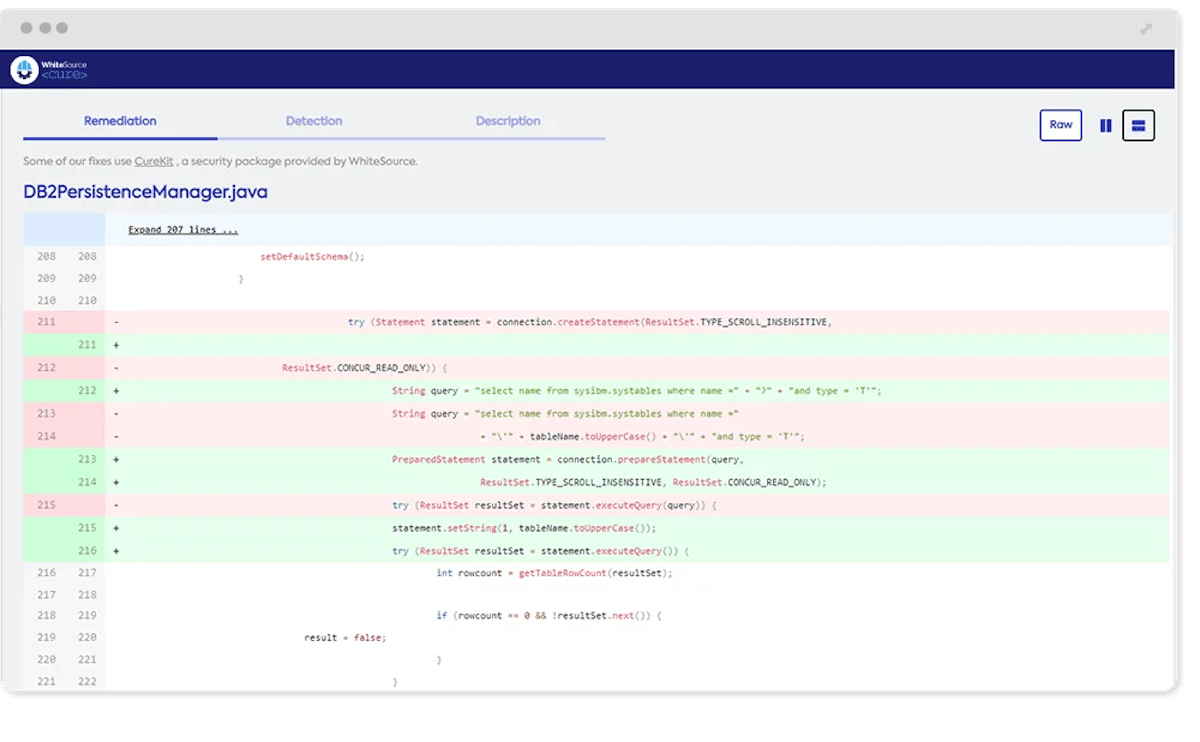
Mend, formerly WhiteSource, is an application security platform. It integrates into your DevOps tools to implement your team’s Application Security (AppSec) program, shifting where your software is vulnerable and where you fix those vulnerabilities earlier in the development process.
Best for:
- Evaluating the security of your applications in testing
- Provides remediation solutions during feedback
Mend best features:
- Evaluates and finds vulnerabilities in open-source packages in your application in real-time
- Easy integration in GitHub
- Provides detailed reports
- Automatically implements code changes for most common vulnerabilities and avoids human error when fixing security holes
- Mend.io team is constantly monitoring and updating vulnerabilities
- Supports all major programming languages, including Java, Python, Ruby, JavaScript, Node.js, C++, and C#, as well as many domain-specific languages
Mend limitations:
- User Interface can be a bit clunky
- Dashboards can be confusing
- Implementation can be difficult for some DevOps pipelines
- Can generate false positives
Mend pricing:
- MEND SCA Advanced: $16,000/year for 20 developers
- MEND SAST Advanced: $16,000/year for 20 developers
- MEND SCA & SAST Advanced: $24,000/year for 20 developers
- MEND Premium (Enterprise): Contact for pricing
Mend ratings and reviews:
- G2: 4.3/5 (90+ reviews)
- Capterra: 4.3/5 (7 reviews)
8. Jira
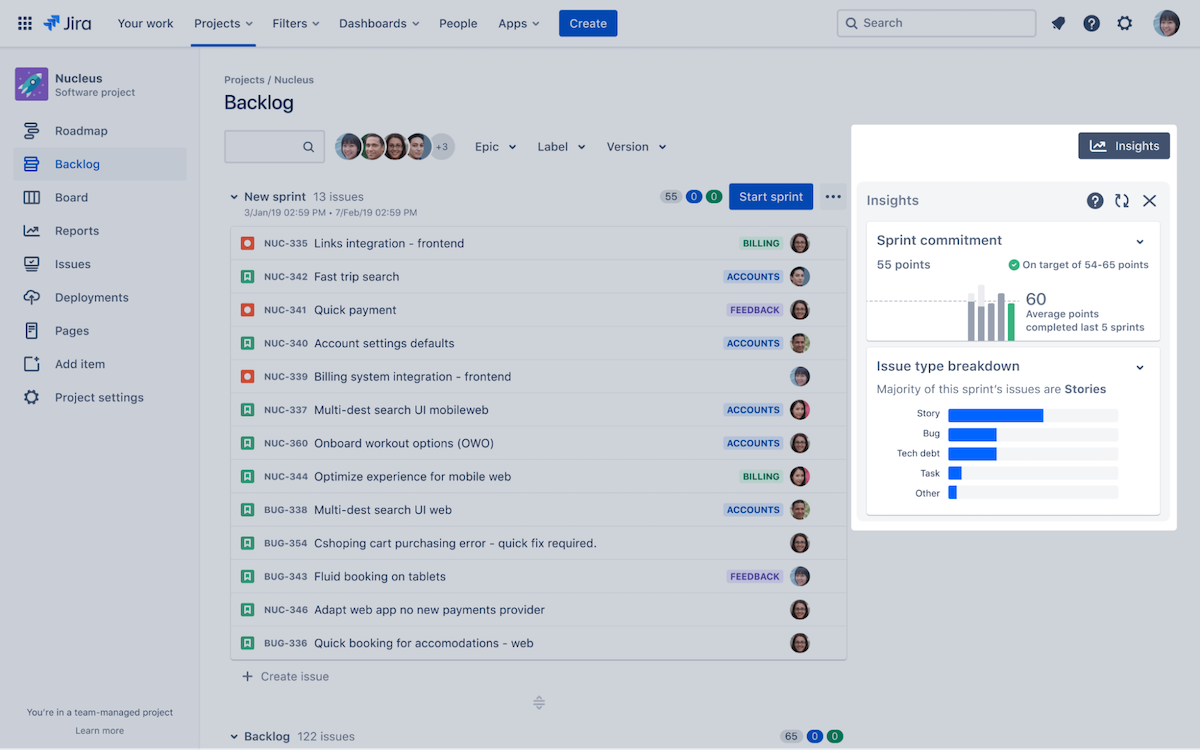
Jira is an issue (bug) tracking and project management tool. It includes agile project management functionality, including workflows, tasks, budgeting and forecasting, and road mapping. It also includes a comprehensive and integrated issue management system for documenting and dealing with bugs in the code and in operations. Jira is part of the Atlassian DevOps suite.
Best for:
- Project management during development
- Issue tracking and automation during feedback and development
Jira best features:
- Built from the ground up for agile with scrum and Kanban methodologies
- Highly customizable
- Very strong at issue management
- Works for many different types of projects, not just software development
- Integrates with many other DevOps tools
Jira limitations:
- Can be difficult to set up and use
- Limited collaboration tools built into the product
- Not set up for multiple teams working together
- It is an issue management tool with project management added in, not a comprehensive project management platform
Jira pricing:
- Free: $0
- Standard: $7.75/month per user
- Premium: $15.25/month per user
- Enterprise: Contact for pricing
Jira ratings and reviews:
- G2: 4.3/5 (5,200+ reviews)
- Capterra: 4.4/5 (13,100+ reviews)
9. Bitbucket
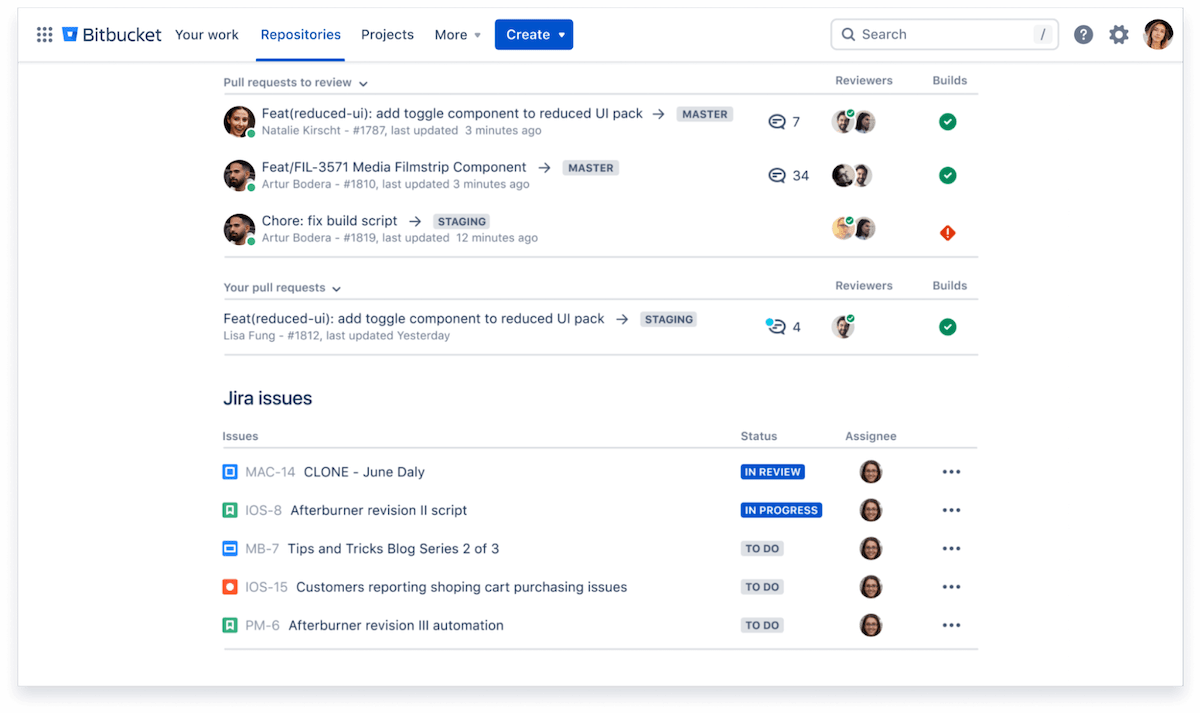
Bitbucket is an alternative software source code hosting platform with version control, also built on Git. It includes CI/CD tools and is focused on supporting users of Jira. It is designed to enable collaboration within a development team. Bitbucket is part of the Atlassian DevOps suite.
Best for:
- Distributed version and access control for integration
- Automated workflows for deployment
Bitbucket best features:
- Tightly integrated with Jira
- Modern and clean user interface
- Strong configuration tools for organizing complex projects, including branching
- Powerful code review tools
Bitbucket limitations:
- Designed to work with other Atlassian products, integration is minimal with other tools
- Limited features when compared to other version control platforms
- Less popular than other similar tools, so the community of users is small, as are the plugin options
Bitbucket pricing:
- Free: $0
- Standard: $3/month per user
- Premium: $6/month per user
Bitbucket ratings and reviews:
- G2: 4.4/5 (800+ reviews)
- Capterra: 4.6/5 (1,200+ reviews)
10. Slack

Slack is a collaboration platform built around instant messaging using the concept of channels. Users can communicate within teams with rich text conversations on a given channel, direct messages between users, video or audio calls (Huddle), asynchronous text and video messages (Clips), or through notebooks (Canvas). It also includes some task management tools.
Best for:
- Collaborating during development
- Capturing the results from testing
- Documenting feedback
Slack best features:
- Simple interface that is easy to navigate
- All the communications for a specific channel are in one place
- Highly customizable
- A large library of integration apps (Check out the best Slack Integrations)
- Powerful search
- Ability to group conversations into threads
- Built-in video conferencing
Slack limitations:
- With its focus on collaboration, you have to load multiple integration apps to increase the functionality
- Can become overwhelming with lots of workspaces and channels
- Task management is limited
Slack pricing:
- Free: $0
- Pro: $7.25/month per user
- Business+: $12.50/month per user
- Enterprise Grid: Contact for pricing
Slack ratings and reviews:
- G2: 4.5/5 (31,200+ reviews)
- Capterra: 4.7/5 (22,900+ reviews)
ClickUp: The Beset DevOps Tool for Your Team
Regardless of what your DevOps playbook looks like, getting your development and operations teams working together doesn’t require magic—it requires the right DevOps tools. They need to work together in a way that enables your processes instead of forcing you to change your processes to fit the tools. 🛠
That is why teams of every type count on ClickUp for project management, collaboration, documentation, and so much more, all in an easy-to-use interface that integrates with the rest of your DevOps tools. So, next time you are putting together a new software project quest, sign up for a free trial of ClickUp and make your life easier. 🤩



